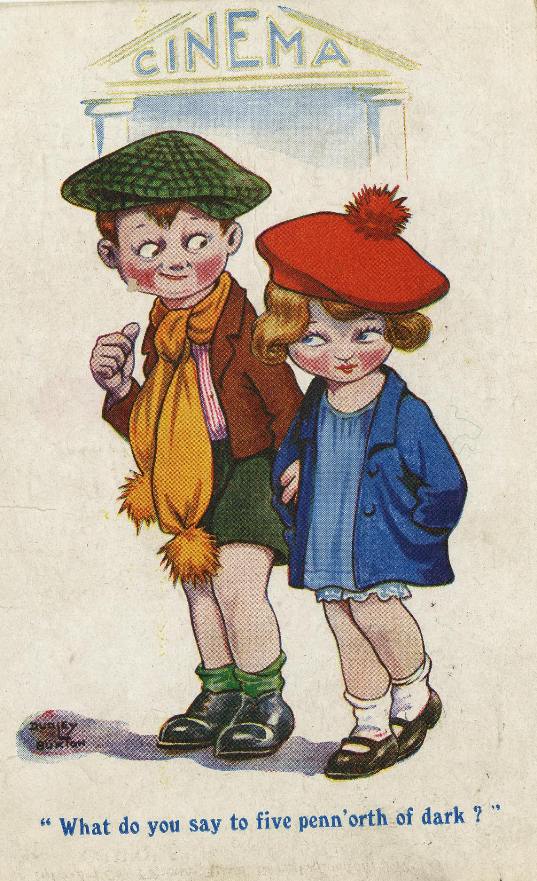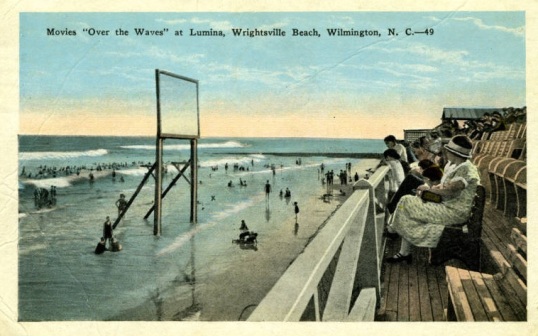Source: J.P. Mayer, British Cinemas and their Audiences: Sociological Studies (London: Dennis Dobson, 1948), pp. 125-127
Text: AGE: 36, SEX: M, OCCUPATION: TRANSPORT MANAGER, FATHER’S OCCUPATION: COMMERCIAL TRAVELLER, NATIONALITY: BRITISH
From an early age I remember being taken by my mother and father to a local cinema every Thursday evening. Most of the films I saw in those days have faded into oblivion, but I still recall laughing very much at Max Linder’s Trip to America, and being very thrilled by Ride on a Runaway Express. Maybe this latter exhibited the first glimmerings of an interest in technique and the moving camera.
However, it remained in abeyance for many years, for when I reached the age of about fourteen, and joined a tennis club, I ceased to take much interest in films. Even in those days, I must have been critically minded, and became tired of the eternal sameness and lack of originality of the majority of films. For several years tennis occupied most of my spare time and only very occasionally did I enter a cinema, attracted by something or other, maybe a star, maybe publicity, (at this date I can recall no important reason), and the result was to keep me in an apathetic attitude to films.
After going to work, I began dropping into films occasionally on the way home from the City. And then something happened. I discovered that there was a way of discriminating between films and that was to find out who directed them. I don’t know how I first got hold of this idea, but it has been my guiding star ever since.
The first film I remember seeing that showed me the possibilities of technique in the film was Asquith’s Shooting Stars, which, although actually directed by A.V. Bramble was mainly interesting because of his script.
About this time I discovered the periodical Close Up, which, high-faluting and precious as much of its writing was, did give me an entirely new angle on films, and made me long to be able to see the films mentioned therein. A few of these, mainly German films, did succeed in getting into cinemas, but it has always been one of my greatest regrets that the film The Love of Jeanne Ney, greatly eulogised in that magazine, I missed when it was generally released round the Gaumont circuit, owing to its being very stupidly renamed Lusts of the Flesh, and my not recognising it in that guise.
It was shortly after this that a little ‘flee-pit’ [sic] in a back street amongst some of the worst slums in … started a programme of ‘screen classics’. ‘Talkies’ had arrived at most cinemas by this time, but the manager was only interested in showing the best of the silents. To this little back-street slum cinema, with wooden forms, came people from all over London to programmes of films never seen before or since. The double feature programme changed twice a week and every film shown was of interest to connoisseurs. During the two or three months this season lasted, we saw Mother, Storm Over Asia, The End of St. Petersburg, Turksib, Earth, The Student of Prague, Warning Shadows, Berlin, La Passion de Jeanne D’Arc, Les Neauveux [sic] Messieurs and many other films of a like nature, some of which thrilled me immensely, especially Turksib, Mother and The Student of Prague.
Always at these shows I made a point of speaking to the manager afterwards to see what treasures he had in store for us. On one of these occasions, I met a girl who was also discussing films with him, and she was reading Paul Rotha’s The Film Till Now. This book had only just been published and was difficult to get hold of, and when I expressed my desire to read it, she took my name and address, and eventually wrote to me and lent me the book.
This book which gives a historical survey of silent film, together with Elmer Rice’s A Voyage to Purilia, which I read shortly afterwards, and which is a brilliant satire on films, bringing in every cliché ever used in films, practically finished my education in cinema. Never again could I be fobbed off with the inferior, the shoddy, the meretricious, the hackneyed story, the inevitable coincidence.
And what since? It has all been rather in the nature of an anti-climax. I had seen the pick of the finest films almost all together, and what masterpieces I have seen since have been spread out over the years, and with the complete submerging of the silent film in the swamp of the talkies, silent films have been seen less and less, except at occasional film societies’ showings or sub-standard versions given by enthusiastic amateurs. And for all the brilliance of some talking films, the complete unity and artistry of the silent films has never been recaptured. The Avenue Pavilion and the Forum continued the good work of the back-street … cinema, and to-day, the number of cinemas has increased but the quality of the films has, alas, very considerably depreciated.
Turksib, which, to this day, is still my number 1 film, and which I have seen 19 times (a film, in my opinion, unlike that of most people who are only interested in seeing a film once, because then they ‘know it’ when it is good enough, should be treated like a symphony, something to experience numerous times, and each time providing new delight) first showed me the scope of the film. Here was a film without actors, and with human beings dwarfed by the magnitude of the theme of the building of a railroad. This interest in the documentary movement, has increased with the years. Here, away from the studios and the aping of the theatre, is the true medium for the film, and until producers realise this, and the public appreciate that the film, like no other medium, can ‘present the world to the world’, as one of the commentators of the ridiculously inadequate newsreels is for-ever telling us, until then the full scope of the film will not be utilised. We have seen a trend in the right direction in many of the magnificent British documentaries and fictional films with a documentary approach, dealing with the War. Let us hope they will appreciate the great power of the film for ‘winning the Peace’.
My interest in films has made me wish to make films myself, but except for a little amateur work, I have never succeeded in getting ‘into’ films, although I have hopes at the moment of entering a small documentary group. In the meantime, I have maintained my interest, by writing occasional articles for various papers, and am at the moment engaged on a history of British Films.
Comments: J.P. (Jacob Peter) Mayer was a German sociologist at the London School of Economics. His British Cinemas and their Audiences collates motion picture autobiographies submitted through competitions in Picturegoer magazine. This contribution comes from the section ‘Films and the Pattern of Life’. The films mentioned are Max Comes Across (USA 1917), A Ride on a Runaway Train (USA 1921), Shooting Stars (UK 1928), Die Liebe der Jeanne Ney (Germany 1927), Mat (USSR 1927), Potomok Chingiskhana (USSR 1928), Konets Sankt-Peterburga (USSR 1927), Turksib (USSR 1929), Der Student von Prag (Germany 1926), Schatten (Germany 1923), Berlin: Die Sinfonie der Großstadt (Germany 1927), La passion de Jeanne d’Arc (France 1928) and Les nouveaux messieurs (France 1929). Paul Rotha’s The Film Till Now was published in 1930; Elmer Rice’s A Voyage to Purilia was published in 1930 (having been serialised in 1929). Close Up was published 1927-1933.



